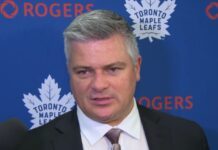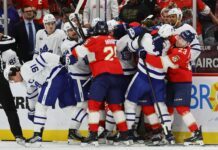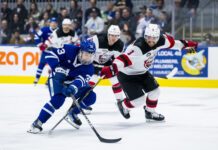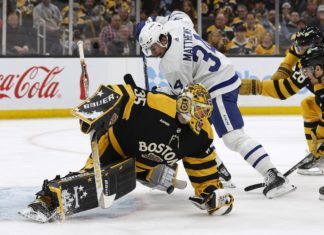After a flurry of departures, promotions and one hiring (so far), the dust is starting to clear in the Toronto Maple Leafs front office. The next step is finding out how they plan to move forward.
The hiring of Kyle Dubas as General Manager and subsequent departures of Lou Lamoriello and Mark Hunter confirmed what became clear when the organization announced that Lamoriello would not be returning. Shortly after that announcement was made, I wrote the following:
I’m fairly comfortable in suggesting that, if Shanahan wanted to keep Lamoriello as GM, he could have — there were no indications that Lou was slowing down with age and the team is on the verge of something special. Who would willingly hand over those reigns?
Barring something unforeseen, the plan is to continue to move forward with the succession plan here. But we’ll talk about Kyle Dubas if and when he is promoted.
Dubas moved quickly to replace the role he was previously occupying, hiring Laurence Gilman, who most notably worked for the Vancouver Canucks (when they were good). He also promoted Brandon Pridham to Assistant General Manager, which essentially leaves one opening left to fill — the head scout role Mark Hunter previously occupied.
All of this comes at a complicated time for the Leafs. They have a foundation laid out with (probably) multiple superstars developing, a high-end second line center, a solid goalie, a few good young defensemen, and depth on the wings. However, contractually, only their second-line center, best defenseman and number-one goalie are locked in long-term; their three best forwards will all need new contracts over the next 15 or so months.
Over the last two seasons, one of the Leafs’ strengths has been outscoring their problems with a high-powered offense. In the coming week, two-thirds of their offensive third line, including a player with 65 goals over the last two seasons (which is tied for 15th with John Tavares in that time), is about to become pending free agents.
The organization does have some depth, as evidenced by the Marlies winning the Calder Cup (more on that below), but that depth is really in net, some promising defensemen, and a collection of wingers. They still lack depth down the middle and have — at a minimum — one real center spot to fill for next season.
All of this roster volatility also means opportunity for improvement.
I’ve said this before and it holds even truer now – this team has not been a great possession for two seasons (13th in corsi in 2016 – 2017 and 17th in 2017 – 2018). They are young and developing, but that’s not where they want to be at the end of the day. They want to dominate the play, and instead they rely on Frederik Andersen, an elite power play, and their overall scoring depth to win games.
With a hole opening up on the third line and potentially even the fourth line, they have the ability to reshape the roster a bit and tilt the ice more in their direction this summer. How they deploy that third line is going to be really telling — as new GM Dubas said shortly after his promotion, “Finding inefficiencies when it comes to our tactical deployment”.
First, let’s consider the Gilman hire and recall the Canucks at their peak.
The 2010 – 2011 Vancouver Canucks are arguably the best regular season team of the post-lockout era. They finished with 117 points, had a +77 goal differential, led the league in goals for, led the league in goals against, owned the number-one power play in the league, and ran out the number-three penalty kill. The only teams that were even comparable in that time period are the 2007 – 2008 Detroit Red Wings, the 2013 – 2014 Boston Bruins, and the 2016 – 2017 Washington Capitals.
The Canucks ran a zone matching system, with their top players – the Sedins – getting a heavy dose of offensive zone starts, while the Manny Malhotra-led third line almost exclusively started in the defensive zone. Ryan Kesler’s was a two-way line that bounced around depending on the matchup. Here is an article by Cam Charron discussing the Canucks zone matching concept further (coincidentally, Charron now works for the Leafs).
The drawback with zone matching is that opponents can dictate matchups on the road. Who goes out in what area of the ice will be predictable and a smart coach can work it to his advantage. That said, the Leafs are deep and skilled enough to take advantage of that. They already have a top line in place with Auston Matthews and William Nylander that they can load up with all the offensive zone starts they can handle, a strong two-way line led by Nazem Kadri, and now an opportunity to remake that third line to handle a heavy workload of defensive zone starts (while a young, Marlies-led fourth line gets sheltered offensive zone starts).
Conversely, the Marlies just won a championship with a very different strategy: building depth on every line and rolling them pretty steadily. Head Coach Sheldon Keefe mentioned this after the Game 3 win against Lehigh Valley, noting, “We’ve got four lines that we just rolled, pretty well the entire night. When we’ve got four lines like that and everybody’s on the same page and playing with purpose, it doesn’t give the other team much opportunity to get going.”
Now, it’s worth noting the Marlies did have an advantage over other teams that the Leafs won’t – no salary cap. They were able to stack their team with AHL All-Stars like Ben Smith, Chris Mueller, Colin Greening, and even Martin Marincin. Eyeballing Cap Friendly, the Marlies spent around $2 million more on their team than their opponents, which is not much of a gap in the NHL, but $2 million can pretty well ice an entire team in the AHL.
When you add in Andreas Johnsson — who was a star — the Marlies could spread out all of these players throughout their lines and form a relentless attack. When injuries and call-ups started affecting the Marlies, that gave players like Mason Marchment, Adam Brooks and Trevor Moore more playing time. Once everyone returned, the team was four good lines deep.
In February of this past season, Babcock made reference to this kind of strategy:
We’re trying to get to a point where we have four lines, you roll them out the door and don’t worry about it.
The Marlies would, of course, start specific units in certain situations over others, but their strength was in their depth. One thing that was interesting to see over the playoffs was the creativity on the bench.
For example, in Game 3 against Texas, Keefe put Mueller out with the top line for an offensive zone draw that resulted in a big goal. The Leafs have rarely mixed things up like this for specific situations — or really in game, in general — unless they were facing a lopsided situation of some kind.
The Leafs could go in this type of direction if they wanted to. William Nylander spent a season in the AHL at center and performed well there, and he was good with the Leafs in the middle before they drafted Matthews. If they are inclined to try him at center and commit to it, they can spread out Matthews, Marner and Nylander on separate lines and fill in each unit with their depth (although Matthews would be lacking the kind of high-talent running mate he should be playing with in this scenario unless they acquire one).
If they are adamant about not playing Nylander at center, Dubas’ first big move might be acquiring a strong center for the 3C hole rather than the defenseman most people are calling for.
Or they could just go for broke and get John Tavares.
That third line and how Leafs brass views its role is going to be really telling as to the overall construction and deployment of the roster.
Notes
- Andreas Johnsson became a Leafs regular down the stretch of the regular season and in their playoff series, giving himself an inside edge at a roster spot next season. He then went back down to the AHL and dominated the playoffs, leading the postseason in scoring and winning the Jack A. Butterfield Trophy for playoff MVP. I took a quick look at the past 20 winners and there is only one All-Star in the group: Carey Price. The next best player in the group is probably Tomas Tatar, but the last three winners were all young forwards that appear reasonably promising: Jordan Weal, Oliver Bjorkstrand, and Tyler Bertuzzi. Maybe not the kind of NHL acclaim people were hoping to see, but there is a clear recent history of young players winning the award and then going onto have productive NHL seasons the following year. Bjorkstrand just completed his first full season after winning MVP and recorded 40 points.
I - In 2014, Johnsson was named the SHL Rookie of the Year, so he is building himself a nice little trophy case. He is turning 24 this season, so expectations do have to be kept in check (the three past winners just mentioned were all younger when they won MVP, for example). At this point, Patrick Marleau is the Leafs’ only true left winger; what’s going to happen with Matt Martin remains to be seen and who knows if the team ever plans on moving Zach Hyman back to his strong side, where he has looked far more comfortable with the puck.
I - If the Leafs continue to run the same right wingers as last season, the current group goes: Nylander – Mitch Marner – Connor Brown – Kasperi Kapanen – Josh Leivo. A lot can potentially change here, particularly if they believe Hyman should be on the right wing or if Nylander slides over to center. In an ideal world, Brown and Kapanen are in the top nine, so how they sort out this group is something to keep an eye on.
I - I thought Justin Holl had a nice showing in the preseason and when he came up to the NHL for two games – the goals aside – he did not look out of place one bit. He ended the year with 28 points in 60 AHL regular season games, and five points in 20 playoff games while playing on the top pairing and all the important situations. He’s 6’3, moves around the ice well, can handle the puck, and produced at a level that suggests he can move up and be a player. I think he can play in the NHL. The Leafs don’t have the deepest defense unit, per se, but with Ron Hainsey playing on the right side, Nikita Zaitsev locked in long-term and Carrick just signed to a decent NHL deal, it’s going to be difficult for him to breakthrough. He is an arbitration-eligible RFA and the contract he gets will be telling.
I - Calle Rosen is another player that had a strong playoff showing and finish to the regular season. Rosen had a very impressive 11 points in 16 postseason games and was all over the ice, consistently joining the rush or taking the puck up himself. He would be another fast defenseman to add to the mix, but at least publicly, he seems to be somewhat forgotten about right now.
I - The Leafs enter the draft with a plethora of NHL-capable goaltenders, but it’s hard to see the summer playing out with all of them sticking around. Frederik Andersen is obviously the starter, but all of Garret Sparks, Calvin Pickard and Curtis McElhinney would require waivers to go down and it’s hard to see two of those three clearing. The Leafs were smart to pay $800,000 on a one-way contract and that was done by design with the hopes of other teams not claiming Pickard. I’m guessing, based on that, they’d like Pickard to be the starter for the Marlies and they will make a decision between Sparks and McElhinney for the Leafs’ backup role.
I - Over the last two seasons, Andersen has started the second most regular season games and played the second most minutes of any goalie. Their general philosophy in net has been to only play the backup goalie on the second half of back-to-backs, despite McElhinney turning in a strong season in 2017-18. Down the stretch, Andersen appeared not himself at times; after March, he posted a .896 save percentage the rest of the way.
I - With all of Tyler Bozak, JVR, Leo Komarov, Tomas Plekanec, Dominic Moore and Roman Polak about to hit the market, the Leafs are basically losing all of their veterans (not to mention what is going to happen with Matt Martin and Curtis McElhinney). If everyone departs, that will leave the team with only Patrick Marleau and Ron Hainsey as players over 30. Worth keeping an eye on: If the Leafs feel the need to target some veterans to complement their still-very-young squad (this would seem to be a Babcock preference).
I - Other than potentially making a pitch for Tavares, I imagine the Leafs go bargain/potentially veteran shopping in free agency.
I - The Leafs go into the draft with seven draft picks – four of which are their own. They have all of their picks still for the following two drafts, as well as an extra fourth round pick from the Nikita Soshnikov trade, and an extra seventh round pick from the Eric Fehr trade.

































